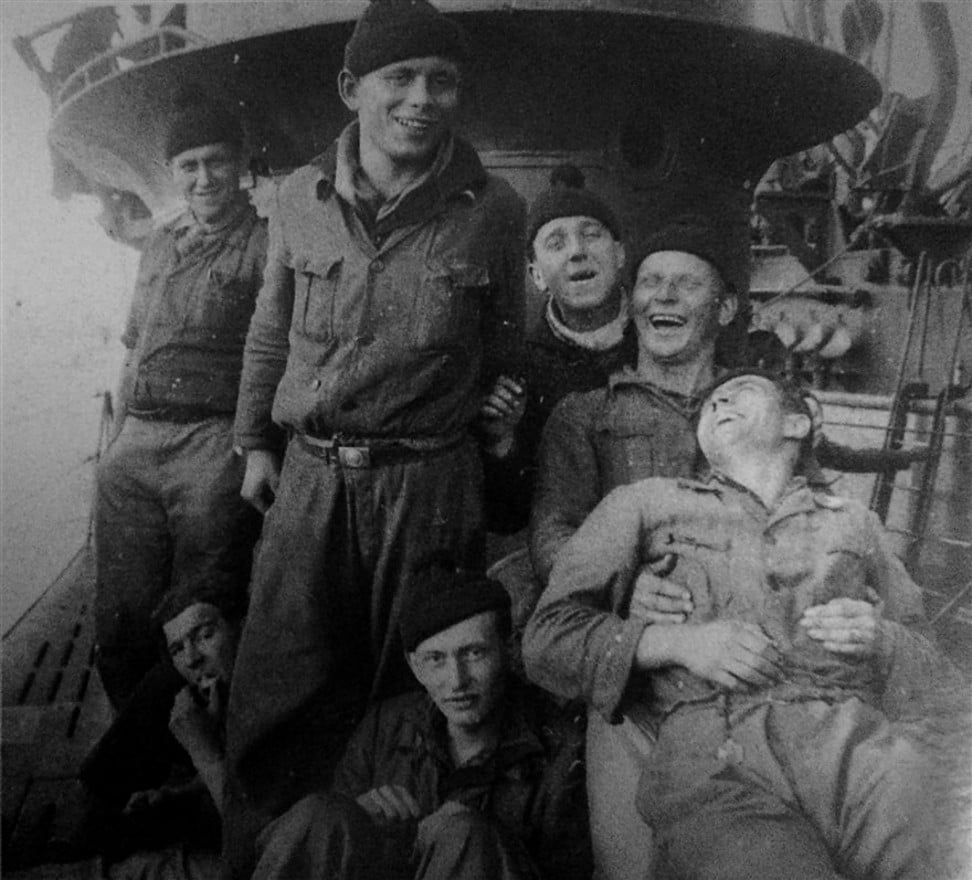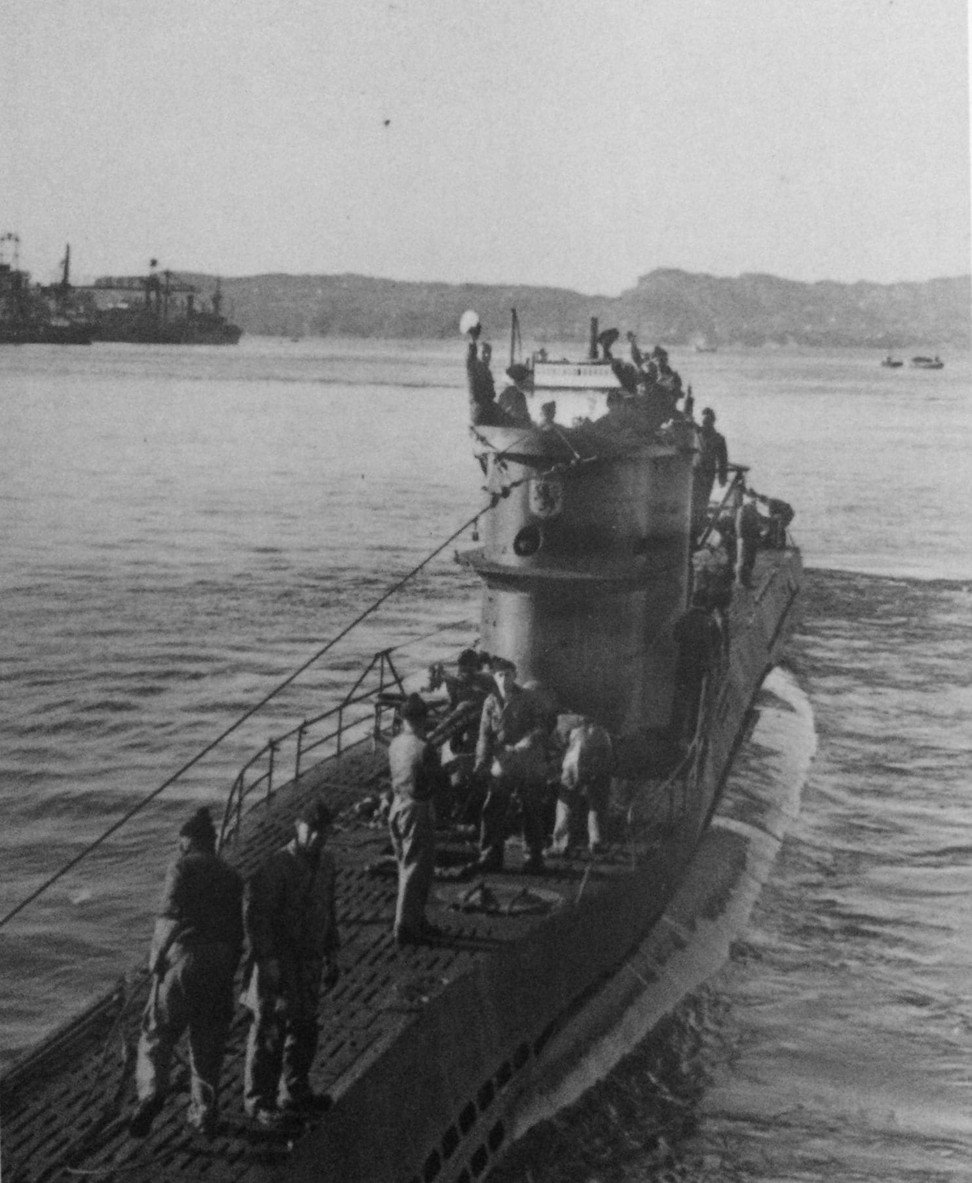
Lasers help tell ghostly story of doomed Nazi submarine U-576 and its entombed crew
- A laser scan shows the sunken U-boat off the coast of North Carolina resting in 210 metres of water
- Entombed are dozens of German sailors

The U-boat seems to loom out of the blackness, careening to starboard, as if to avoid a collision.
As it glides by in the image, its deck gun is unmanned, its conning tower empty, the wooden deck plates are rotted away.
It is German submarine U-576, Kapitanleutnant Hans-Dieter Heinicke, in command.
And as it “passes”, its outline appears in laser-generated colours of fluorescent blues and greens.
It’s a ghost ship, resting in darkness in about 210 metres of water (700 feet) off North Carolina since 1942, with Heinicke and 44 sailors entombed within.
But a National Oceanic and Atmospheric (NOAA) laser survey has now revealed the boat in high-resolution, somewhat psychedelic detail.
“It’s the clearest picture I’ve seen of any U-boat on the seabed,” said Joe Hoyt, a senior NOAA archaeologist who helped direct the project.
“It’s a pretty stunning image … For me, it’s kind of the beginning of a new era of what’s possible.”
“We’re at a point now with marine science and technology that we can visualise these things in a way that we couldn’t before,” he said.
“Our goal here is to sort of virtually raise (these vessels) … essentially bringing these stories to the surface.”

It’s the clearest picture I’ve seen of any U-boat on the seabed
The survey stems from an expedition two summers ago, in which technicians and maritime archaeologists from NOAA and other agencies descended to the bottom in submersibles to study the wreck about 55km (35 miles) off Ocracoke, North Carolina.
Among other things, a complex laser scan was conducted to get a clear picture of what remains of the boat after 74 years below water and answer some lingering questions.
“What was it that put the 576 on the bottom?” Hoyt said.
“Did the crew get out of the sub?”
The scan revealed a submarine that is mysteriously intact. There appears to be no battle damage and no damage from a hard impact with the bottom, as in an uncontrolled sinking, Hoyt said.
That suggests that the boat might have submerged to the bottom intentionally to play possum, and then couldn’t surface again; or it might have had some mechanical problem or unseen damage.
It could still have been structurally sound at that depth, Hoyt said.

“It was completely within its operation depth range,” which was about 750 feet, he said.
But there’s no indication that the crew got out.
“There’s only a few points of egress in and out of the sub,” he said. U-boats did have some escape apparatus.
“We could see pretty … clearly that all of the hatches were sealed. So we knew at that point that the entire crew was still on-board.”
In the scan, the sub’s deck gun, nicknamed “Peterle”, little Peter, and conning tower are clearly visible. The emblem on its conning tower in wartime photos – a standing lion holding a large key – is not visible.
“We looked for that and could not see it,” Hoyt said.
The bright green and blue colours were chosen for the image to better show contrast and clarity said David Alberg, supervisor of NOAA’s offshore Monitor National Marine Sanctuary.
Toward the stern, one of its screw propellers can be seen near a diving plane. The deck is a lattice of missing plates.

The hatch on an ammunition storage area is shut.
U-576 was a type VIIC German sub, a workhorse of the fleet and the kind of vessel depicted in the popular 1981 submarine film Das Boot, the Boat.
U-576 remains the property of the German government, but the United States has agreed to care for it, NOAA has said.
The sub was located in 2014, but it was not until August 2016 that anyone laid eyes on it since it went down in battle on July 15, 1942.
That afternoon, Kapitanleutnant Heinicke made a fateful decision. He was in a crippled, unlucky boat that had nearly been destroyed by an aircraft attack a day or two before.
The attack had affected a ballast tank and hampered the boat’s ability to dive and surface.

Heinicke, 29, was the son of a German cavalry officer who had been killed in the first world war. He was an experienced, observant commander who had been in the navy for almost a decade.
He had been at sea for 29 days, departing the massive concrete U-boat pens at St. Nazaire, France, on June 16, 1942.
It was his fifth patrol in a year-old boat. But he had bagged only three ships and was plagued with engine problems.
He had destroyed the armed British freighter Empire Spring, off Nova Scotia, killing all 55 hands aboard in February 1942, according to the website Uboat.net.
On April 30, 1942, he hit the Norwegian vessel, Taborfjell, with two torpedoes off Cape Cod. It went down in about a minute. Only three of its 20-man crew survived.
But nine days earlier, when he torpedoed the American freighter Pipestone County off Norfolk, Virginia, he surfaced near the lifeboats.
He gave the survivors provisions and apologised for sinking the ship. There were no fatalities.
Now, Heinicke had signalled to his superiors that the damage from the air attack could not be repaired. He was headed east, perhaps toward home, and reported that day that he had made 16 miles, running on the surface in moderate seas.
Then he encountered allied convoy KS-520 – 19 merchant ships and five escorts, bound from Virginia’s Hampton Roads to Key West, Florida.
They made a juicy target, and despite his hobbled boat, he decided to attack.
Heinicke fired four torpedoes. Two hit and damaged the Chilore, an American freighter, according to NOAA. One hit and damaged the big Panamanian tanker J.A. Mowinckel, and the fourth sank the Nicaraguan freighter Bluefields.
But after firing the torpedoes, the U-boat inexplicably popped to the surface in the middle of the convoy. Patrolling aeroplanes and gunners on one of the convoy ships pounced.
Seaplanes dropped depth charges, one of which slid off the sub’s hull and exploded, according to the National Archives.
Debris flew. The sub headed down, leaving a smear of black oil on the water.
Three days later, German headquarters asked U-576 to report.
There was no reply.